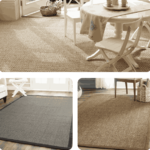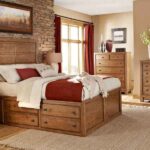There is no denying the classic and elegant appeal of leather furniture, but when mold grows on it, you have a serious problem that needs to be handled carefully and right away. The presence of mold on leather furniture can be dangerous for your health in addition to endangering its aesthetic appeal. This thorough investigation explores the origins, mitigation, and efficacious methods for removing mold from leather furniture, offering insightful knowledge on how to preserve the quality of these opulent pieces.
The Hidden Threat: Decoding Mold Growth on Leather Furniture
The emergence of mold on leather furniture is more than just an aesthetic issue; it is an indication that fungi are growing on the organic components of the leather. Due to their ubiquity in the environment, mold spores thrive in moist, humid environments and penetrate the leather’s permeable surface. This unwanted guest appears in several forms, such as fuzzy growths or discolorations, and needs to be addressed right once to protect the furniture’s aesthetic value and the health and safety of the occupants.
How Mold Finds Its Way into Leather Furniture
Effective prevention of mold formation on leather furniture requires an understanding of its underlying causes. The main catalyst, moisture, can enter leather through a number of different channels. Unchecked, mold-promoting conditions can flourish, such as high humidity, water spills, or poor ventilation. Furthermore, the porous structure of leather makes it a perfect place for mold to grow, particularly when combined with inadequate air circulation.
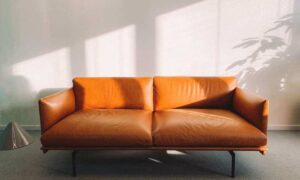
Identifying Mold Growth on Leather Furniture
The first line of protection against mold on leather furniture is recognition. It’s critical to keep an eye out for warning indicators like discolored areas, a musty smell, or obvious fuzziness on the surface. It is important to inspect below the surface as well since mold might seep into the leather’s underlying layers. Early detection makes it possible to act quickly and stop the problem from getting worse.
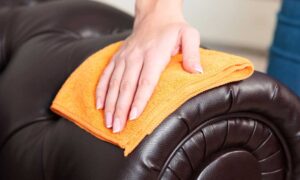
Safeguarding Your Leather Furniture
Preventive measures provide a strong barrier against the growth of mold on leather furniture. Maintaining ideal indoor humidity levels, which are normally between 30% and 50%, should be the first priority for initiatives. When dehumidifiers are used in humid settings, the air stays dry and makes it difficult for mold to grow. To get rid of possible moisture sources, it’s important to conduct routine inspections and take immediate action when water leaks or spills occur. Arranging furniture in a way that keeps it away from windows or damp walls helps reduce the chance of mold growing.
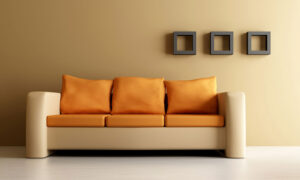
Prioritizing Ventilation and Air Circulation
One powerful tool in the fight against mold on leather furniture is proper ventilation. It is crucial to make sure that the space where leather furniture is kept gets enough airflow. This can be accomplished by opening windows, using fans, or carefully arranging furniture to provide free movement of air. The presence of fresh air prevents moisture from building up, which makes the atmosphere unsuitable for the growth of mold.
Cleansing Leather Furniture to Deter Mold Growth
Cleaning leather furniture on a regular basis is essential to preventing mold growth. Gently wiping down leather with a moderate, pH-balanced leather cleanser guarantees that dust is removed and that organic debris that could harbor mold is not allowed to accumulate. Because leather is sensitive to moisture, it is important to use caution when using large amounts of water. Periodic treatment with a leather conditioner maintains suppleness while inhibiting mold growth.
Immediate Action Against Mold Infestation
- When leather Povison furniture becomes contaminated by mold, prompt action is necessary. Spores are kept from spreading by starting with the furniture that is afflicted and is isolated. Loose mold particles can be removed by using a gentle brush attachment when vacuuming the surface.
- Applying a mild solution of white vinegar and water to the impacted areas will help get rid of persistent mold.
- Vinegar’s gentle acidity facilitates the breakdown of mold without sacrificing the leather’s structural integrity.
Natural Remediation for Mold on Leather
It works well to use sunshine as a natural cure for mold on leather furniture. The damaged furniture is exposed to ultraviolet (UV) rays, which have the ability to suppress the growth of mold, when it is placed in direct sunlight. This acts as a preventive measure in addition to helping to remove the mold. Leather can become damaged by prolonged exposure to sunlight, thus caution should be taken to prevent this.
Silica Gel and Charcoal Absorption
Combating mold on leather furniture entails deploying natural moisture absorbers. Activated charcoal or silica gel packets placed close to the furniture absorb excess moisture and serve as silent guardians against the formation of mold. To keep these absorbers effective, they must be periodically replaced or regenerated.
Seeking Mold Remediation Experts
When the situation gets serious, it seems sense to hire mold treatment experts. These professionals have the knowledge and resources necessary to determine the full degree of the mold infestation, create a thorough cleanup strategy, and bring leather furniture back to its former splendor. Their involvement guarantees complete mold removal, reducing the likelihood of recurrence.

Leather Furniture Restoration and Preservation
The process of restoring and preserving leather furniture starts as soon as the mold threat is defeated. Leather may be nourished and regained its sheen by using cleaning and conditioning products designed specifically for leather. Leather furniture is strengthened against future mold infestations by putting preventive measures in place, such as routine cleaning and maintaining ideal interior conditions.
Conclusion
Although mold on leather furniture can be a difficult problem to solve, with the right information and preventative steps, the beauty of these priceless items can be restored. This guide provides individuals with the necessary tools to negotiate the complex terrain of mold management on leather furniture, from understanding the reasons to putting prevention methods into practice and carrying out efficient removal processes. Maintaining the integrity of leather furniture guarantees that it will age gracefully and elegantly.





